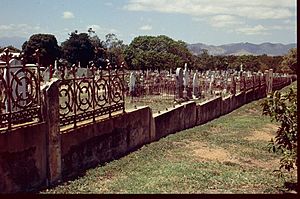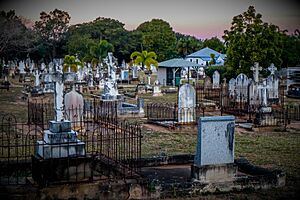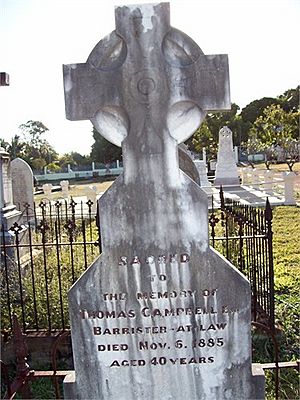West End Cemetery facts for kids
Quick facts for kids West End Cemetery |
|
|---|---|

West End Cemetery
|
|
| Location | Francis Street, West End, City of Townsville, Queensland, Australia |
| Design period | 1840s - 1860s (mid-19th century) |
| Built | 1865 - 1930s |
| Official name: West End Cemetery, Townsville General Cemetery | |
| Type | state heritage (built, landscape) |
| Designated | 4 June 1996 |
| Reference no. | 601475 |
| Significant period | 1865- (social) 1865-1930s (fabric, historical) |
| Significant components | headstone, grave surrounds/railings, pathway/walkway, memorial/monument, cemetery, denominational divisions, burial/grave, tree groups - avenue of, fence/wall - perimeter |
| Lua error in Module:Location_map at line 420: attempt to index field 'wikibase' (a nil value). | |
West End Cemetery is a very old and important cemetery in Townsville, Queensland, Australia. It is located on Francis Street in the area known as West End. People were buried here from 1865 until the 1930s. It is also called Townsville General Cemetery. This cemetery is so important that it was added to the Queensland Heritage Register on June 4, 1996. This means it is a special place that needs to be protected.
Contents
History of West End Cemetery
How Townsville's First Cemetery Started
West End Cemetery was officially planned in 1865. It was Townsville's first official cemetery. Before this, there was another burial ground near the beach in North Ward. But that one was quickly left behind as the town grew. It was never an official cemetery.
The West End Cemetery was surveyed in November 1865. It was located west of the main town area, near Ross Creek. It covered about 19 acres at the bottom of Castle Hill. Even though it wasn't officially made a cemetery until 1872, people started using it earlier. The first known burial was in March 1868. This was for Captain Henry Daniel Sinclair, who helped start the town of Bowen.
Managing the Cemetery
For a few years, there was no official group looking after the cemetery. In 1868, a group of people started raising money to build a fence around it. The fence was finished by July 1869. But there were still no official managers, called "trustees," and no one was keeping a record of burials.
Finally, in August 1872, the West End Cemetery became an official reserve. Trustees were appointed to manage it. They then set up rules for the cemetery in July 1873. A burial register, which is a list of all burials, was also started that year.
Changes to the Cemetery's Size
At first, getting to the cemetery was tricky because you had to cross private land. In 1880, the trustees tried to make the cemetery bigger to create an official entrance from Flinders Street West. But this plan was cancelled in 1884.
In 1886, a small part of the cemetery was taken away for a school. To make up for this, new land was added to the cemetery. This new land, about 5 acres, was at the corner of Church Street and Flinders Street West. This helped create a better entrance.
The Cemetery and Townsville's Growth
When the cemetery was first planned in 1865, it was far outside Townsville. But within ten years, the town grew quickly. The area around the cemetery, known as West End, became a busy suburb. By the 1890s, West End was a thriving area with shops and businesses. A state school was also built next to the cemetery.
As the town grew, people worried about the cemetery's location. They were concerned that rainwater from Castle Hill might flow through the cemetery and pollute a nearby creek. So, in the 1890s, the trustees started looking for a new place for Townsville's main cemetery.
On November 10, 1900, a new, much larger cemetery was opened at Belgian Gardens. After 1902, new burial plots were no longer sold at West End Cemetery. However, it was not completely closed yet.
The Cemetery in the 20th Century
With the new cemetery at Belgian Gardens, the West End Cemetery struggled to get money for upkeep. In 1901, the trustees gave up about 3 acres of the cemetery that wasn't fenced. This land became a recreation area managed by the Townsville Municipal Council.
However, the Council didn't improve the recreation area. So, in 1910, most of that land was given back to the cemetery. A new road, now Pridmore Street, was created. This road led to the main entrance of the cemetery, which had a path lined with trees.
West End Cemetery was officially closed in 1930. After this, only people who had already bought plots could be buried there. Since 1930, about 288 people have been buried in family graves at West End. In 1935, another 3 acres were taken from the cemetery and added to the nearby school.
During World War II, a camp for workers was set up on the unfenced part of the cemetery. It is thought that the original entrance gates were removed at this time. A new entrance was made off Church Street. This unfenced area became a recreation reserve again in 1958. Since then, the cemetery has been about 15 acres.
Monument Makers and Damage
Two important companies made many of the headstones and grave surrounds in West End Cemetery. Melrose and Fenwick made headstones and iron fences for graves from the late 1800s until 1984. Whebells also made headstones from the late 1800s to the 1950s.
On December 24, 1971, Cyclone Althea caused a lot of damage to the headstones and trees. Over the years, some graves have also been damaged by vandals or neglect. However, in recent years, local people have worked hard to save the cemetery. In 1996, the Townsville City Council started a plan to help care for and maintain West End Cemetery.
What You Can See Today
West End Cemetery is located on the southern side of Castle Hill. It has different sections, or "blocks," for graves. There are two paths that divide the cemetery into Blocks A, B, C, and D. These paths meet a creek on the eastern side.
Between the creek and the school is Block E. This section was used for burials that were not part of a specific religious group. Graves of Chinese, Jewish, and Aboriginal people are in this section. Not many headstones are left in Block E. Some graves might have been washed away by floods. Unlike many cemeteries, West End is not divided into different religious sections, except for Block E. Most graves face east, which is a common tradition.
Trees and Fences
You can see large banyan, fig, and mango trees in the cemetery. There is also a line of mahogany trees that marks the original entrance. Along Church Street, there is an old fence made of stone and cast iron. The roots of large banyan trees have grown over parts of this fence and nearby graves. The main entrance, off Church Street, seems to have been built at the same time as this fence.
Headstones and Materials
West End Cemetery has many beautiful and well-made headstones. They show how monumental architecture changed in Queensland from the 1860s to the early 1900s. The oldest headstone is from March 4, 1868.
The headstones are made from different materials:
- Marble: The first marble headstones came from Carrara in Italy. After 1939, marble from Ulam, near Rockhampton, was used.
- Sandstone: This stone was not found locally. It was brought from places like Helidon Quarry near Toowoomba, Coffs Harbour in New South Wales, and around Sydney.
- Granite: Local granite came from Magnetic Island and pink granite from Hervey Range and Castle Hill.
- Concrete: Newer headstones and graves are made from cast concrete and are simpler in design.
Many graves built between 1896 and 1919, about 52 percent, have ironwork fences around them.
Important People Buried Here
Many important early residents of Townsville and North Queensland are buried in West End Cemetery:
- Andrew Ball: He helped found Townsville and was an important businessman. He was buried in 1894.
- John Deane: He was a member of both the Queensland Legislative Assembly and the Queensland Legislative Council, which are parts of the state government.
- Thomas Campbell: He was also a member of the Queensland Legislative Assembly.
- William Hann: An early settler in the Kennedy District, which is a region in North Queensland. He was buried in 1889.
- Charles Rowe: He was a business partner with John Melton Black, who built a large cattle farming business in North Queensland. He was buried in 1900.
- Thankful Willmett: A printer and businessman.
- George Burns: A member of the Queensland Legislative Assembly (MLA).
- Captain Henry Daniel Sinclair: He helped found the town of Bowen.
There is also a large mound in Block A. People say it is a shared grave for children who died during an epidemic in the 1890s.
Why This Place is Special
West End Cemetery was added to the Queensland Heritage Register on June 4, 1996. This means it meets certain important standards.
Showing Queensland's History
West End Cemetery helps us understand the history of Townsville and the surrounding area. It also shows how monument designs changed in the late 1800s and early 1900s.
The cemetery was Townsville's main cemetery from around 1868 to 1902. It holds the graves of people who were very important to the history of Townsville, the region, and all of Queensland.
A Unique Part of History
This cemetery offers a special look into the past. It gives us unique historical information about how Townsville and North Queensland grew.
A Great Example of a Cemetery
The cemetery is still very much like a 19th-century Queensland cemetery. It has old headstones, trees, and perimeter fences. It helps us learn about the work of people who made monuments and how cemeteries were designed in Queensland.
Beautiful and Moving
The different types of memorials, its location at the base of Castle Hill, the trees, and the fences all make the cemetery a beautiful and meaningful place.
Important to the Community
The people of Townsville value this cemetery. It is connected to the city's early founders, and many local families have relatives buried there. This makes it important for social, cultural, and spiritual reasons.
Connected to Important People
West End Cemetery is strongly linked to important people in Townsville, regional, and Queensland history. These include Andrew Ball (founder of Townsville), William Hann (an early settler), George Burns (an early Townsville politician), and Captain Sinclair (founder of Bowen). It also holds the graves of many Townsville mayors and other important citizens.



